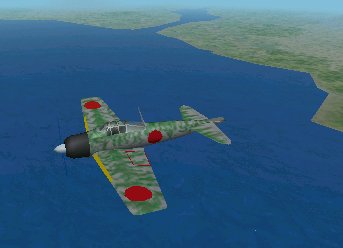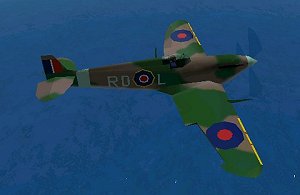Landing a Damaged Aircraft
Landing a damaged aircraft in Warbirds can be a challenge depending on the type of damage you have
accumulated. Some things can be dealt with quite simply, while several "simple" things damaged on the
same flight can be quite difficult. Obviously losing a wing or the rear half of your aircraft makes your primarily
focus your parachute, rather than how to land.
The goal of landing ANY damaged aircraft is to reach the end of a runway (long runway if possible), while
meeting the necessary parameters for a safe touch down and roll out. These parameters include Attitude
(how your aircraft is oriented at impact), Speed, Rate of Descent (very important), and Control Settings
(gear, flaps, and trim).
Non-Critical Damage
Flaps - as long as you control your airspeed on landing, flaps are not necessary
Rudder - Be sure your line up is correct, using aileron rolls to correct your course until you must level wings.
One Aileron - Use trim often while changing speed on your descent to insure you do not get into an
uncontrolled roll. Use rudder input to compensate for aileron. You can also use the fuselage as a foil while
banked.
Engine Oil - This necessitates a quick return to base or a ditch. Often it is safer to cut your engine early to
save it for the actual touchdown, rather than land a "dead stick" plane.
This is all the more true with inline and water-cooled engines. The radials, such as in the P-47 and the
Fw-190A series will last a bit longer, but they will go out on you eventually.
The best advice is to climb if you can, so that you can glide it in on approach. The same is true of a fuel leak.
Climb whenever in doubt.
If you have a twin-engined aircraft, you still need to get home soon. Watch the engine temperature. As it
goes into the red zone, feather the damaged engine (Ctrl + 1 or 2) and shut it down. This will cause
considerable yaw that trim cannot overcome. You will need to add rudder to keep a true course.
Critical Damage
Elevator - Obviously more serious, use manual trim (K key) to trim the nose up as best you can, and do not
let airspeed get below 200 mph on landing. Once you learn this landing, it is very repeatable.
Stabilizers - Both the horizontal and vertical Stabilizer are VERY critical issues once lost. Trim out as best
you can and bank the aircraft as needed to maintain control. Again I find higher speed will be safer and
more controllable. If you are in a "One life to Live" situation, this might be a good time to learn Sky Diving.
Wings/Fuselage - You can keep a wingless plane aloft for quite some time with proper inputs... but at
some point you're going to have to get out.
Combination Damage - Many times you will have multiple control surfaces damaged. In this situation, you
are more limited since many emergency measures involve replacing one input with the use of another. If
both are gone, it will be much more difficult to land the aircraft, but NOT impossible.
Getting Home
The most important thing to do, once clear of combat and on the flight home, is to evaluate what condition
your aircraft is in, and what type of control you have left. Can you turn left or right? Can you control your alt?
Will your descent accelerate beyond your ability to slow it? Will your control get worse at lower speeds?
All these questions are going to determine whether you get down safely or not, so it's always better to find
out before you get down low and slow. Try a controlled landing descent to an altitude you decide. Was the
speed within tolerance? What about the descent rate? If you cannot get control, you're most likely going to
lose it on the approach.
Lastly, some critically damaged aircraft can be landed... with practice. Rather than bail, keep in mind that if
you can get your plane to about 10 feet of alt over the threshold of the runway at a reasonable speed, you
might be able to make it. You might as well practice it when it doesn't count (in the Main Arena), because
some day it might be nice to know how (in a Scenario).
Landing a damaged aircraft in Warbirds can be a challenge depending on the type of damage you have
accumulated. Some things can be dealt with quite simply, while several "simple" things damaged on the
same flight can be quite difficult. Obviously losing a wing or the rear half of your aircraft makes your primarily
focus your parachute, rather than how to land.
The goal of landing ANY damaged aircraft is to reach the end of a runway (long runway if possible), while
meeting the necessary parameters for a safe touch down and roll out. These parameters include Attitude
(how your aircraft is oriented at impact), Speed, Rate of Descent (very important), and Control Settings
(gear, flaps, and trim).
Non-Critical Damage
Flaps - as long as you control your airspeed on landing, flaps are not necessary
Rudder - Be sure your line up is correct, using aileron rolls to correct your course until you must level wings.
One Aileron - Use trim often while changing speed on your descent to insure you do not get into an
uncontrolled roll. Use rudder input to compensate for aileron. You can also use the fuselage as a foil while
banked.
Engine Oil - This necessitates a quick return to base or a ditch. Often it is safer to cut your engine early to
save it for the actual touchdown, rather than land a "dead stick" plane.
This is all the more true with inline and water-cooled engines. The radials, such as in the P-47 and the
Fw-190A series will last a bit longer, but they will go out on you eventually.
The best advice is to climb if you can, so that you can glide it in on approach. The same is true of a fuel leak.
Climb whenever in doubt.
If you have a twin-engined aircraft, you still need to get home soon. Watch the engine temperature. As it
goes into the red zone, feather the damaged engine (Ctrl + 1 or 2) and shut it down. This will cause
considerable yaw that trim cannot overcome. You will need to add rudder to keep a true course.
Critical Damage
Elevator - Obviously more serious, use manual trim (K key) to trim the nose up as best you can, and do not
let airspeed get below 200 mph on landing. Once you learn this landing, it is very repeatable.
Stabilizers - Both the horizontal and vertical Stabilizer are VERY critical issues once lost. Trim out as best
you can and bank the aircraft as needed to maintain control. Again I find higher speed will be safer and
more controllable. If you are in a "One life to Live" situation, this might be a good time to learn Sky Diving.
Wings/Fuselage - You can keep a wingless plane aloft for quite some time with proper inputs... but at
some point you're going to have to get out.
Combination Damage - Many times you will have multiple control surfaces damaged. In this situation, you
are more limited since many emergency measures involve replacing one input with the use of another. If
both are gone, it will be much more difficult to land the aircraft, but NOT impossible.
Getting Home
The most important thing to do, once clear of combat and on the flight home, is to evaluate what condition
your aircraft is in, and what type of control you have left. Can you turn left or right? Can you control your alt?
Will your descent accelerate beyond your ability to slow it? Will your control get worse at lower speeds?
All these questions are going to determine whether you get down safely or not, so it's always better to find
out before you get down low and slow. Try a controlled landing descent to an altitude you decide. Was the
speed within tolerance? What about the descent rate? If you cannot get control, you're most likely going to
lose it on the approach.
Lastly, some critically damaged aircraft can be landed... with practice. Rather than bail, keep in mind that if
you can get your plane to about 10 feet of alt over the threshold of the runway at a reasonable speed, you
might be able to make it. You might as well practice it when it doesn't count (in the Main Arena), because
some day it might be nice to know how (in a Scenario).

